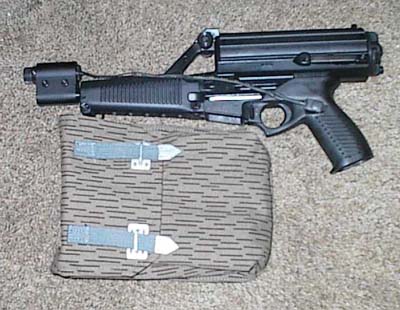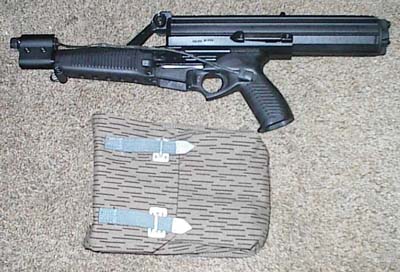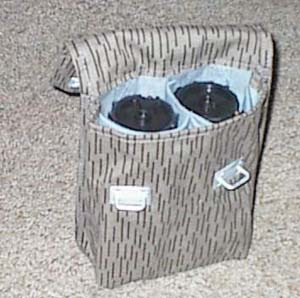
The Calico M-950 Pistol

|
The Calico | ||||
| Caliber | Dimensions | Barrel | Weight | Magazine | Action Type |
| 9MM | 14x6.9x3.1 | 7.5" | 2.25 pounds | 50 | Semi Auto |
The gun is exceptionally accurate, and dependable. I have never had a single stoppage, even with some of the hotter handloads that I use (147gr@1100+fps).There is a specially made holster for this pistol, required because of the unique shape. The holster is attached to the weapon via a special holder which is screwed into mounting holes on the receiver. This is similar to the design of the Uzi holsters, and is probably based on their design. I have attempted to use Uncle Mikes holsters for the larger, scoped Contender, but these do not work. The major obstacle to using a regular holster is not the size of the gun as much as it is the cocking lever on the left side of the receiver. There is also a wrist strap which fits on the front sling swivel. There are swivels on the front and rear of the gun, though I see no practical use for a full sling.
 The lower photo shows the same pistol with the 100 round carbine magazine
mounted.
The lower photo shows the same pistol with the 100 round carbine magazine
mounted. These guns use the same scope mount, brass catcher, and Kelly grip, as the larger, carbine version, though there is a shorter laser mount available. The gun balances, and points well. The size, and weight, along with the high position of the sights, make it very easy to shoot. From a tactical point of view, this arm is the ultimate entry weapon. This is the same class of weapon as the well regarded Uzi, Ingram, and Styer. All of these weapons are semi auto versions of compact submachine guns; the Calico is no exception. There are several different models of fully automatic Calicos available (to law enforcement only, of course).
Though the Calico may be classed as a machine pistol, it certainly outclasses it's competition. With the exception of the new Styer, the other machine pistols seem a bit crude in comparison to the Calico. These weapons tend to be stamped, welded, and pinned together, the fit and finish being of military quality. All of these guns were designed to be cheap, and fast to produce. Their present high prices are a reflection of the restrictions placed upon them rather than any cost incurred during their production. The molded, and cast components of the Calico seem quite elegant by comparison, and there is nothing else to compare to the unique magazine. Much of this is due to the age of these weapons. The current crop of submachine guns, and machine pistols, have their origins in the fifties, and sixties. The Calico was designed in the nineties, based on the original .22 version, which was designed in the eighties. During the intervening decades, new alloys, and polymers were developed, along with new methods of casting, forming, and working with them. Glock pioneered the use of these polymers in firearms, and the state of the art in light alloys was extended by the firearms and aircraft industries. These advances were integrated into the Calicos, putting them at least a full generation ahead of their competition. The Calico also fires from a closed bolt, and has a locking action, both features being very uncommon in this class of weapon.

My particular example sports a laser sight, with a pressure pad switch. This gun is ideally suited to a laser sight, particularly when firing from the hip, a natural tendency for this type of weapon. The laser is a typical low end unit, secured to the weapon via a clamp mount on the end of the barrel. The laser is a viable sighting aid indoors; it is also useful in the outdoors at night, or during the day at very close range. This fits in pretty well with the tactical situations in which a weapon of this type is usually used. The trigger has a weird, mushy feel to it, with no break at all. I never even feel the release, which may actually enhance accuracy, since there is no way to really be able to tell when release will occur, until the weapon actually fires.
This is a pre-ban weapon, and post ban versions are available, equipped with magazines from the remaining stock of pre-ban manufacture. There seems to be no difference bettween the pre-ban and post-ban versions, other than the much higher cost, and somewhat limited availability. I am uncertain as to whether the current offerings are from left over pre-ban production, or if Calico is actually still allowed to produce them, sans the high capacity mags.